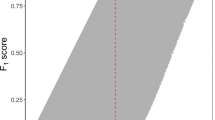Abstract
Partial least square (PLS) analysis is the most favourite tool in chemometrics to develop calibration models. PLS technique allows us to decipher even the complex systems by analysing all the variables instead of looking at them one at a time. PLS technique not only capture the maximum variation associated with predictor (i.e. spectra) and predicted (i.e. concentration) variables but also maximises the correlation between them. The present article describes the working scheme of the PLS algorithm. It also describes important technical details that need to be considered for developing a parsimonious and robust calibration model.
Similar content being viewed by others
Suggested Reading
D L Massart, B G M Vandeginste, L M.C Buydens, S de Jong, P J Lewi, V J S Verbeke, Handbook of chemometrics and qualimetrics, Elsevier, New York, 1997.
R Kramer, Chemometric techniques for quantitative analysis, Marcel Dekker, New York, 1998.
R Brereton, Chemometrics for Pattern Recognition, John Wiley & Sons, Ltd, U.K., 2009.
S Wold, Chemometrics, What do we mean with it, and what do want from it, Chemometrics and Intelligent Laboratory Systems, Vol.30, pp. 109–115, 1995.
K Kumar, Principal Component Analysis: Most Favourite Tool in Chemometrics, Resonance, Vol.22, pp.747–759, 2017.
S Wold, PLS-regression: a basic tool of chemometrics, Chemometrics and Intelligent Laboratory Systems, Vol.58, pp.109–130, 2001.
A Höskuldsson, PLS regression methods, Journal of Chemometrics, Vol.2, pp.211–228, 1988.
G G Dumancas, S Ramasahayam, G Bello, J Hughes, R Kramer, Chemometric regression techniques as emerging, powerful tools in genetic association studies, Trends in Analytical Chemistry, Vol.74, pp.79–88, 2015.
R G Brereton, Applied Chemometrics for Scientists, John Wiley & Sons, Ltd, U.K., 2007.
R G Brereton, Chemometrics: Data Analysis for the Laboratory and Chemical Plant, John Wiley & Sons, Ltd, U.K., 2003.
R G Brereton, Chemometrics: Data Driven Extraction for Science, John Wiley and sons, Ltd, U.K., 2018.
K Varmuza, P Filzmoser, Introduction to Multivariate Statistical Analysis in Chemometrics, Taylor & Francis Group, Boca Raton, FL, 2008.
R G D Steel, J H Torrie, Principles and Procedures of Statistics, McGraw-Hill, New York, 1960.
Acknowledgment
The data used in the current article was collected during my PhD at Department of Chemistry, Indian Institute of Technology-Madras
Author information
Authors and Affiliations
Corresponding author
Additional information
Keshav Kumar is working as a postdoc scientist at Geisenheim University of Applied Sciences, Germany. His research mainly focuses on chemometrics and its application in various fields. He obtained his PhD from the Department of Chemistry, Indian Institute of Technology, Madras, India, under the guidance of Professor A K Mishra.
Rights and permissions
About this article
Cite this article
Kumar, K. Partial Least Square (PLS) Analysis. Reson 26, 429–442 (2021). https://doi.org/10.1007/s12045-021-1140-1
Published:
Issue Date:
DOI: https://doi.org/10.1007/s12045-021-1140-1




